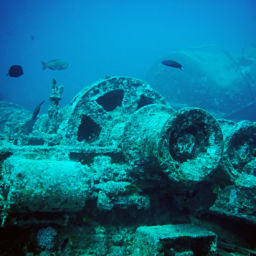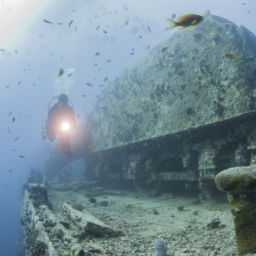The Thistlegorm was on its way to the Mediterranean city of Alexandria, Egypt with supplies for the war effort in the African theatre, but because of Nazi presence in the area, the ship wasn’t able to take the direct route, which would have taken it through the Straits of Gibraltar. Instead, it took the long way around, heading down the African west coast, rounding the Cape of Good Hope and heading back up the east coast of Africa and into the Red Sea. Here, it anchored south of the Gulf of Suez, waiting for the all clear to continue its voyage. While waiting, it was struck by bombs dropped by a Nazi Heinkel He-111 and sank in the early hours of October 6th, 1941. The wreck lay forgotten in the waters between the Sinai and Egypt’s African coast until discovered by Jacques-Yves Cousteau in the 1950s.
The wreck is massive, and attracts a lot of marine life, but the dive’s real attractions are the easy penetration possibilities and the cargo, which includes Bren rifles, BSA motorcycles, Bedford trucks, armored vehicles, airplane parts and even a train. The train wagons are on the top forward deck, but the two train engines dropped off the ship as it sank, and are now located a little way off from the wreck itself.
The Thistlegorm was deliberately anchored up away from shore; this was considered safer, as the lack of any artificial lights made it harder for aircraft to spot anchored ships. Today this means that the wreck is only accessible by boats, which can site reach the site from both Sharm el-Sheikh and Hurghada. Sailing time is considerable, about 3 to 4 hours from both. The best way to dive the Thistlegorm is via liveaboard, which will put you on the wreck first thing in the morning, before all the day boats.
Currents can be fairly strong in the area, so dive guides will often adjust the dive plan accordingly. Some experience with diving in currents is an advantage, though there are numerous nooks and crannies in the wreck where you can seek shelter.



